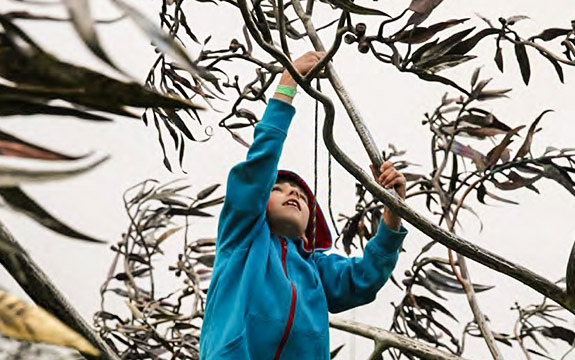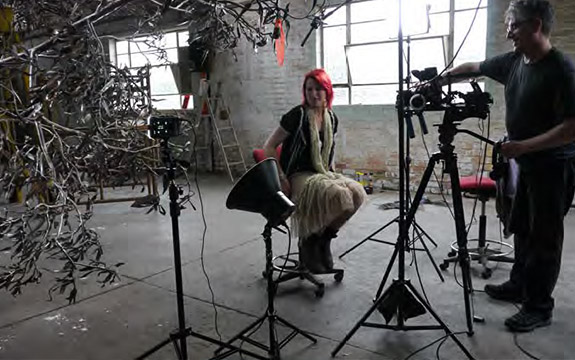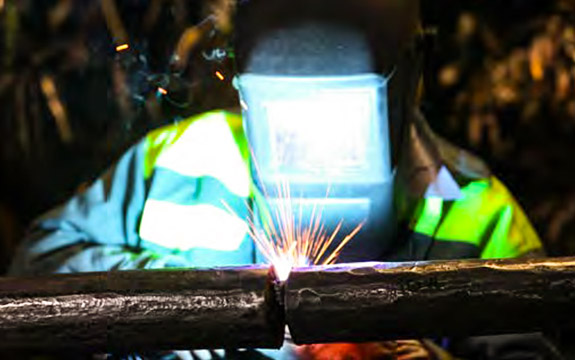Black Saturday documentary shows community’s response to devastation

In Summary
- Documentary film directed by Swinburne’s Andrew Garton explores aftermath of Black Saturday bushfires
- Screenings are being held in affected communities and at Swinburne
- A guide outlining how to screen the film sensitively has been produced by Swinburne staff and students
A documentary on the Black Saturday bushfires, directed by Swinburne Adjunct Industry Fellow Andrew Garton, is being shown to affected communities this week to mark the tenth anniversary of the tragedy. It will be screened at Swinburne later this month.
Forged from Fire tells the story of how a community responded to the Black Saturday bushfires, a series of fires that devastated parts of Victoria and left 173 people dead in February 2009.
In response to the fires, blacksmiths, welders, artists and volunteers worked together to create an ambitious public artwork and memorial: a three-tonne stainless steel and copper gum tree named The Blacksmiths’ Tree.
Community building
After returning from Europe to pursue an artists’ residency near Melbourne, Mr Garton saw first-hand the effects of the fires.
“The day after I arrived in Melbourne, the entire north-east was devastated by firestorms of a magnitude never seen before,” says Mr Garton.
After Black Saturday, Mr Garton met Amanda Gibson, the project lead behind the artwork that would become known as The Blacksmiths’ Tree. Through his time working on the project, Mr Garton documented the manufacturing process, the community-building and the human story behind the creation of the monumental 9.8 metre sculpture.

Artist Amanda Gibson led a team to create a three-tone stainless steel and copper gum tree sculpture as a response to the Black Saturday bushfires.
“Myth was talked up every day and the Tree became something mystical,” he says.
“Volunteers found themselves dedicated to seeing the Tree completed and those following its progress on social media found a means to elevate their hopes beyond grief, beyond suffering, beyond the personal losses so many had, and continue, to endure.”
A guide to sensitivity
Swinburne students Lili Korndorffer and Jenni Aldred, under supervision from Dr Danielle Williamson and Dr Jessica Mackelprang from the Department of Psychological Sciences, have created a guide for communities and organisations who host screenings of the film.
“This guide features information about how hosts can be sensitive to audience members who have experienced trauma, practical ideas to support connection and post-traumatic growth, and support resources for audience members,” says Dr Williamson.

A team of blacksmiths, welders and artists worked together on the ambitious sculpture.
Screening the film
Dr Carolynne White from Swinburne’s Social Innovation Research Institute has been involved in organising a public Swinburne screening of the film on Thursday 28 February, taking care to cater to those who may have been affected by the tragedy.
“As an occupational therapist and health promotion lecturer, my research interests involve how shared activities, such as the creation of The Blacksmith’s Tree and viewing the Forged From Fire documentary, can support individuals and communities to connect and heal after a traumatic event,” says Dr White.
“While formal health services have an important role, community initiatives such as the Tree project, are essential in supporting the mental health of communities.”
For more information about the film and to find a screening, see: Forged from Fire
Assistance for Swinburne staff is available through the Employee Assistance Program providing 24/7 counselling for all staff as well as direct family members.
Swinburne offers staff and students many support options.
For general support, help is available via Lifeline anytime by calling 131 114. Trauma support is also available through the BetterHealth Channel.

